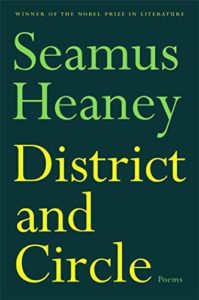Things, moments, people, poems. Heaney finds inspiration for the poems in District and Circle in things that he encounters or imagines, moments he hopes to preserve or evoke in others, people he remembers, and poems he either recalls or translates. Places, which loomed larger in other collections, are less present here, though of course they are not wholly absent as springs of inspiration. He opens with a thing, a very palpable thing, “The Turnip-Snedder.” I expect that upon reading the title only a minuscule slice of Heaney’s audience would know what a snedder is, but 20 lines later readers will not only have a very clear idea of a snedder, but also a sense of its physicality, the sounds it makes, and its metaphysical role in turning one form of life into another. He follows with “A Shiver,” a sonnet describing and meditating on swinging a sledgehammer. Like the first poem in his first collection, “Digging,” this poem links the physical aspects of work with the internal, the spiritual aspects of creating. Heaney has often spoken of the ways that poems should move or shift as they progress, a movement the swinger of the sledge needs too: “spine and waist/A pivot for the tight-braced, tilting rib-cage.” Poets and poems have this as well, “gathered force like a long-nursed rage/About to be let fly.” The mature Heaney is less certain than his younger self. Where the younger man wrote “Between my finger and my thumb/The squat pen rests./I’ll dig with it.” the older one asks
…does it do you good
To have known it in your bones, directable,
Withholdable at will,
A first blow that could make air of a wall,
A last one so unanswerably landed
The staked earth quailed and shivered in the handle?
As in Electric Light, Heaney engages in considerable dialogue with other poets through translations, dedications and other forms of conversation. “Anything Can Happen” is styled “after Horace, Odes, I, 34.” Rilke gets a translation with “Rilke, After the Fire.” Heaney wonders about Greece and Ireland, about life and death, about poetry and political engagement all in the page and a half of “To George Seferis in the Underworld.” And then there’s the short delight of “Wordsworth’s Skates,” clearly inspired by a museum exhibit, but refusing to be bound to it, as the poet cannot be wholly bound by the material.
Not the bootless runners lying toppled
In dust in a display case,
Their bindings perished,
–
But the reel of them on frozen Windermere
As he flashed from the clutch of earth along its curve
And left it scored.
From the Irish he translates “Poet to Blacksmith,” Eoghan Rua Ó Súilleabháin’s instructions to Séamus MacGerailt, another poem about the solidity of tools and the importance of craftsmanship, “And best thing of all, the ring of it, sweet as a bell.” Heaney memorializes both Ted Hughes and Czeslaw Milosz. The poem for Hughes quotes a conversation the two had about Hughes meeting T.S. Eliot, where Hughes said Eliot’s gaze was like “Watching the prow of the Queen Mary/Come towards you, very slowly.” After Hughes’ death, Heaney writes
Now it seems
I’m standing on a pierhead watching him
All the while watching me as he rows out
And a wooden end-stopped stern
Labours and shimmers and dips,
Making no real headway
Should one of the departed fade into the distance? Are they content to be tied by memory to the land of the living? Heaney leaves it for the reader to decide.
The Polish poet receives a three-part send-off, “Out of This World.” The first “‘Like everybody else…'” reflects on the Catholic upbringing they both had in Europe’s eastern and western ends, how Heaney, like Milosz, gradually fell away from it — “There was never a scene/Where I had it out with myself or another./The loss occurred off-stage.” — but never left it completely behind. For him, words like “thanksgiving” or “host” will always “have an undying/tremor and draw, like well water far down.” In “Brancardier” he considers a pilgrimage to Lourdes, a place where Heaney in his youth served as an assistant, carrying stretchers of the sick hoping for a cure. “Saw Music” compares painting, the music made by a Christmastime Belfast busker drawing a bow across a saw, and the poetry both Milosz and Heaney made their calling.
“The art of oil painting —
Daubs fixed on a canvas — is a paltry thing
Compared with what cries out to be expressed,”
–
The poet said, who lies this god-beamed day
Coffined in Krakow, as out of this world now
As the untranscendent music of the saw
He might have heard in Vilnius or Warsaw
–
And would not have renounced, however paltry.
That would be a fitting end to this review, but Heaney has quite a bit still to offer in District and Circle. There are his experiments with prose poems in “Found Prose” and part of “Senior Infants.” There are the place poems of “In Iowa” and “Höfn,” the later trying to capture some of the awe of Iceland’s glaciers seen from the air. There are the six almost science fictional sonnets of “The Tollund Man in Springtime.” Heaney has written about the Tollund Man — an Iron Age man found in 1950, naturally mummified in a bog in Denmark — on previous occasions, particularly in Wintering Out. In the present volume, he imagines the Tollund Man leaving his display case and experiencing the modern world. There’s the sly humor of “Fiddleheads,” addressed to a friend and critic in Japan who said the erotic belonged in poetry. All of this and more.

